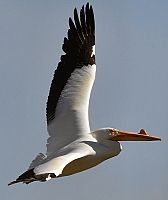Consider the Christian Symbolism of the Pelican
As we approach the holy season of Easter, let us contemplate the pelican, a most unlikely looking bird with an enormous bill that waddles on land but glides gracefully through the air, and whose name is derived from an ancient Greek word pelekys, meaning axe.
Fossil evidence for the pelican dates back at least 30 million years. Of the eight species of the genus Pelecanus alive today, the great white pelican would have been known to the ancient Greeks. So too would have the Dalmatian pelican, the world’s largest freshwater bird, which makes its nest in eastern Europe.
During the breeding season, the Dalmatian pelican’s pouch turns blood red, and the birds often press their bills against their chest to empty them of the water scooped up as they fish before allowing their young to reach into the pouch for food. This likely is the source of the myth that pelicans pluck feathers from their breast until they bleed and use the blood to feed their young. St. Thomas Aquinas referred to this belief in his hymn “Adoro te devote:”
“Lord Jesus, Good Pelican,
Wash my filthiness and clean me with your blood,
One drop of which can free
the entire world of all its sins.”
Another version of the myth has the mother pelican in a fit of pique killing her young then, struck with remorse three days later, resurrecting them with her own blood. The Physiologus, a Christian work from second-century Alexandria, tells the story this way: “The little pelicans strike their parents, and the parents, striking back, kill them. But on the third day the mother pelican strikes and opens her side and pours blood over her dead young. In this way they are revivified and made well.”
Here, then, is an explanation for the depiction found in many Catholic churches of a pelican feeding its young with its own blood, and it is fitting, too, that Corpus Christi College in both Cambridge and in Oxford have pelicans on the coats of arms.
On our side of the ocean, the brown pelican is featured on the seals of Louisiana State University and Tulane University. Although Louisianans attach no religious connotations to their state bird, the brown pelican has in a sense been resurrected, for in North America the species was nearly killed off by pesticides – in 1963 Louisiana, the Pelican State, had not one recorded sighting of a brown pelican even though 25 years earlier 5,000 breeding pairs were reported. However, after DDT was banned in 1972, the brown pelican was reintroduced into Louisiana, and the species was removed from the federal endangered species list in 2009.
Also having recovered from the devastation of DDT is the other species of pelican in the United States, the American white pelican, a stately bird whose squadrons can be seen soaring south and west from Minnesota. While Australian pelicans have the largest bill in the avian world, of birds in North America the white pelican has a wingspan second only to that of the California condor, and it competes with the trumpeter swan for the title of the longest native bird.
Notable, too, is that the white pelican often fishes cooperatively, swimming in a line with others of its kind to drive fish to shallow water where they can be scooped up more easily. They also continue to care for their young for up to three weeks after fledging.
Yet the white pelican is not an entirely laudable species: they are known to steal fish from other pelicans in their nesting colonies as they disgorge their food for their young. We can find another Biblical parallel as well, for if the white pelican female lays more than one egg, a rivalry on the scale of Cain and Abel causes one chick to harass to death or outright kill its sibling.
Likewise, we Christians have our noble qualities as we seek to follow the risen Lord, but often we are found to have “struck God by serving the creature rather than the Creator,” as the Epiphanius Physiologus states. And yet unlike the mythical pelican that struck back at its young, our Lord “deigned to ascend the cross, and when His side was pierced, blood and water gushed forth unto our salvation and eternal life.”
This is the Easter mystery we contemplate as we seek the grace to, in the words of Dante, lean upon the breast of Christ, our pelican.
Marie Mischel is editor of the Intermountain Catholic.
© Copyright 2024 The Diocese of Salt Lake City. All rights reserved.



Stay Connected With Us